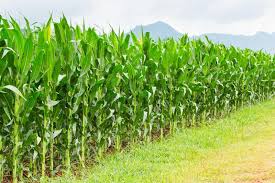CORN OR MAIZE
CLIMATIC AND SOIL REQUIREMENT:
Corn or Maize whose botanical name is Zea mays requires well-drained loam and silt loams at average temperature 24°C. Rainfall should be well distributed for most of the growing period.
Land preparation: Cutting trees, de-stumping and burning precede planting. Land preparation should be done before the rainy season. It should commence in April and May, for May/June planting. On coastal areas, the land should be ploughed 15 - 20 cm deep and harrowed to break clods and level the land. In the wet season, ridges should be formed for adequate drainage. No ridging is necessary on sand soils.
Planting: Corn is propagated by seed. Seeds rate per hectare is from 17 to 28 kg. Seeds should be treated with fungicides before planting. Spacing is done in rows 90 cm apart and 30 cm apart within the rows, to a depth of 2-4cm. Two seeds are sown per hill (hole). When the seedlings are 15cm-high they should be thinned to 1 or 2 seedlings per stand, leaving the sturdy, vigorously growing seedlings in each stand.
Irrigation: It is necessary for dry weather when there is water shortage,
Pests: Weeds and pests of corn like armyworms, aphids, birds, should be controlled with herbicides and pesticides.
Fertilizer Application: Corn needs additional nutrients for vigorous growth. Fertilizer is best-placed 5cm below the soil and 5cm away from the seed at planting. The second application of fertilizer is done 30 days after planting; placed 15cm away from the rows of young plants.
Harvesting: Maize is harvested with hand, by a downward twisting action 3-4 months after planting. Combined harvester can be used on a large scale. Harvesting time is reached when the silk first becomes brown and the ears feel plump.
Economic Importance: Corn is rich in carbohydrates. Trie embryo or germ of the grain is fairly high in protein. The yellow variety is fairly rich in carotene, which produces Vitamin A. The young cobs are boiled and grains were eaten. Dried grains are crushed into smaller pieces and made into a variety of dishes and as livestock feed.


No comments:
Post a Comment